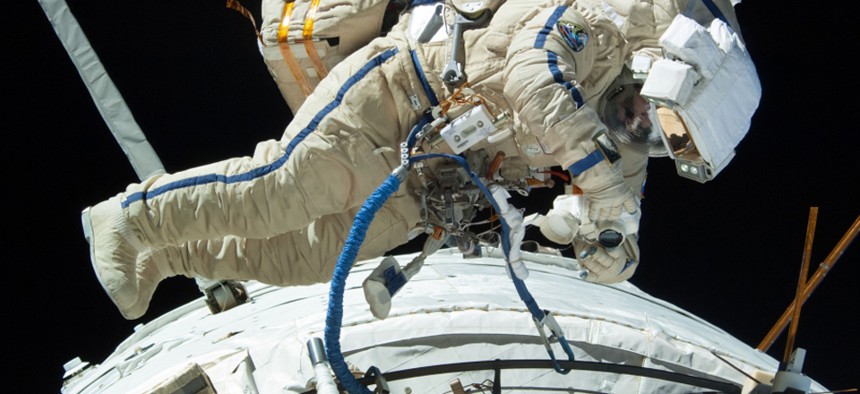When NASA Cut Ties With Russia, Was It Really Targeting Congress?

Russian cosmonaut Alexander Misurki works on the International Space Station in 2013. NASA
Crimea created an opportunity to restart the space race and push for a full space budget.
NASA’s decision to stop cooperating with Russia came as a surprise Wednesday, including within the American space agency.
Even after the Verge broke the story with a leak from a NASA scientist—who had received a memo outlining the policy change—the agency couldn’t muster a response for six hours. When it did, it noted that the boycott won’t be total: “NASA and Roscosmos will, however, continue to work together to maintain safe and continuous operation of the International Space Station.” That will have come as a relief to Steven Swanson and Richard Mastracchio, the two American astronauts currently on the station, since the US needs Russia until 2017 to shuttle its astronauts back and forth. But while the agency said the move was due to “Russia’s ongoing violation of Ukraine’s sovereignty and territorial integrity,” it looks more like a convenient way to put the heat on American politicians, rather than Russian ones.
While US-Russian space cooperation began during the Cold War, when the two countries were ostensibly in an ideological nuclear death match, space diplomacy doesn’t have such a big place today. For example, Congressional Republicans currently forbid NASA from cooperating with China’s space program, despite the fact that trade, diplomatic and military relations between the US and China today are far closer than they were between the US and Russia in the 1970s, when astronauts and cosmonauts shook hands in space.
With the end of the Space Shuttle program, the US hasn’t had the means to get up into orbit, but several private companies—Boeing, SpaceX, and the Sierra Nevada Corporation chief among them—are working with NASA to build a replacement vehicle. Originally, the goal was to select a winning design and have it ready to fly by 2015, but budget cuts have imperiled that deadline, pushing it back to 2017.
Before Russia seized Crimea, this was merely awkward and expensive (NASA and the private space companies maintain launching with US vehicles will ultimately be cheaper than paying Russia $71 million a seat). But with the new tensions, an opportunity has arisen to recreate the space race and push for the full budget. This is evident in the pointed dig that the NASA statement makes at the US Congress:
“…had our plan been fully funded, we would have returned American human spaceflight launches – and the jobs they support – back to the United States next year. With the reduced level of funding approved by Congress, we’re now looking at launching from U.S. soil in 2017. The choice here is between fully funding the plan to bring space launches back to America or continuing to send millions of dollars to the Russians. It’s that simple. The Obama Administration chooses to invest in America – and we are hopeful that Congress will do the same.”
NASA isn’t alone in seeing an opportunity in the Ukraine crisis. Elon Musk, the SpaceX CEO, recently warned that his competitors’ rockets rely on Russian parts, the supply of which could now be disrupted. Boeing and Lockheed Martin’s joint launch venture says, however, that the tensions won’t affect their ability to launch rockets.






